Abstract
During the development of an ELISA to measure anti-DNA antibodies in systemic lupus erythematosus (SLE) sera, native dsDNA was found not to be the most appropriate antigen to use in ELISA assays for differentiating between SLE patients and those with rheumatoid arthritis (RA), a disease also associated with circulating serum anti-DNA antibodies. By modifying the ELISA technique to incorporate human DNA, denatured by reactive oxygen species, to detect anti-DNA antibodies in SLE sera, results consistently showed an increase in antibody binding when compared with the native antigen; no such trend was observed in the comparable group of RA patients. Using this assay serum anti-dsDNA antibody levels were measured in a group of 20 controls, 20 RA patients (10 seropositive and 10 seronegative) and 30 SLE patients (15 with clinically active disease, 15 with inactive disease). A comparison with the standard radioimmunoassay used to measure anti-DNA antibodies for the diagnosis of SLE showed that the ELISA assay using modified DNA performed better than the standard radioimmunoassay offering an improvement in both clinical specificity and sensitivity. The improved method particularly reduced the problem of false-negative results for SLE patients shown clinically to be either mildly active or inactive.
Full text
PDF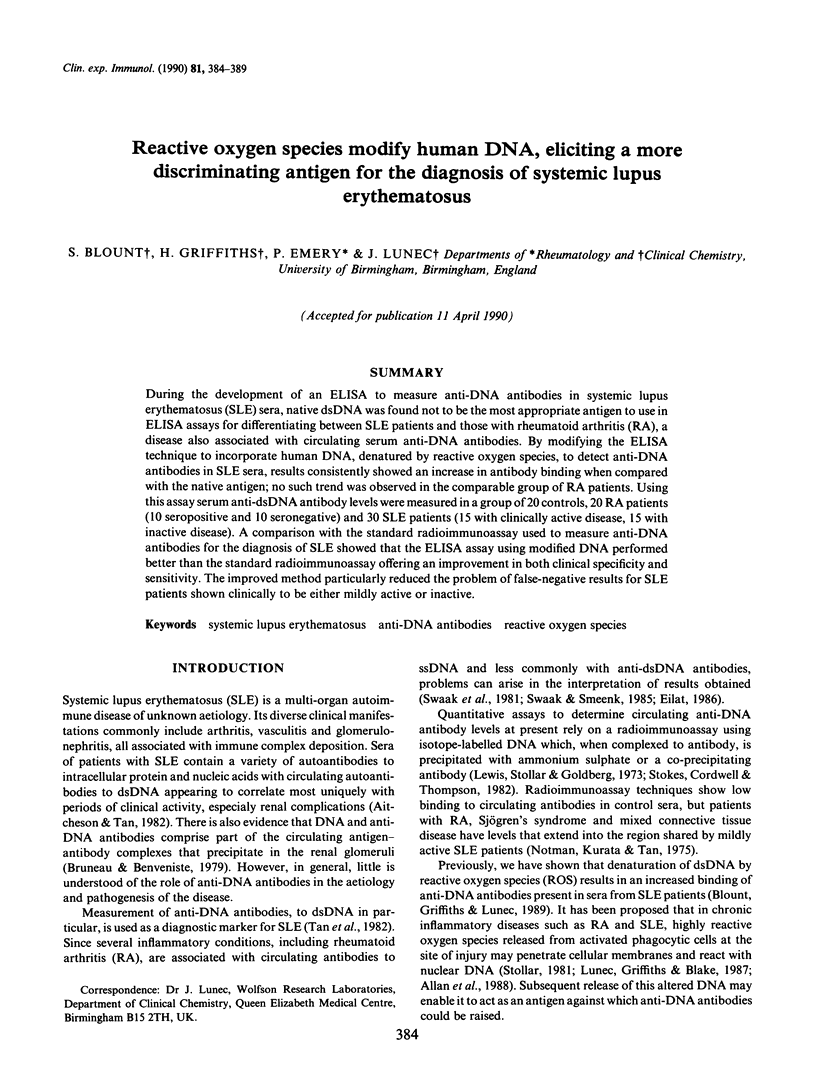
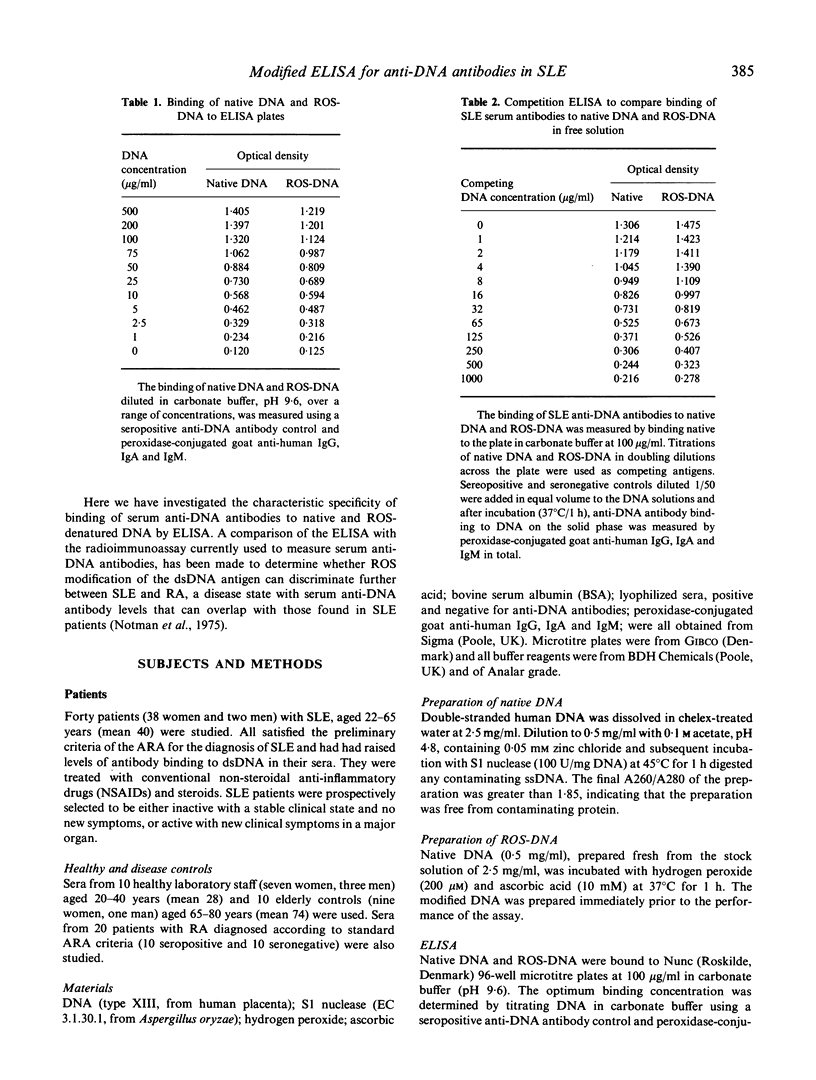
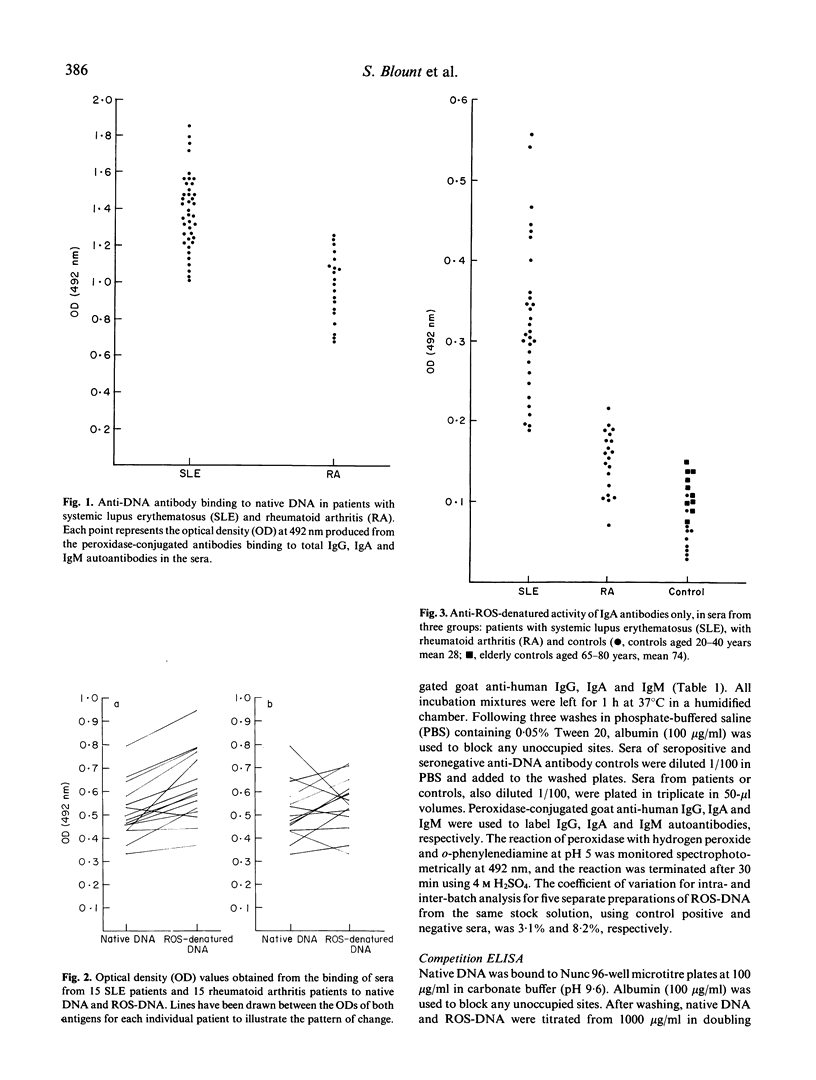

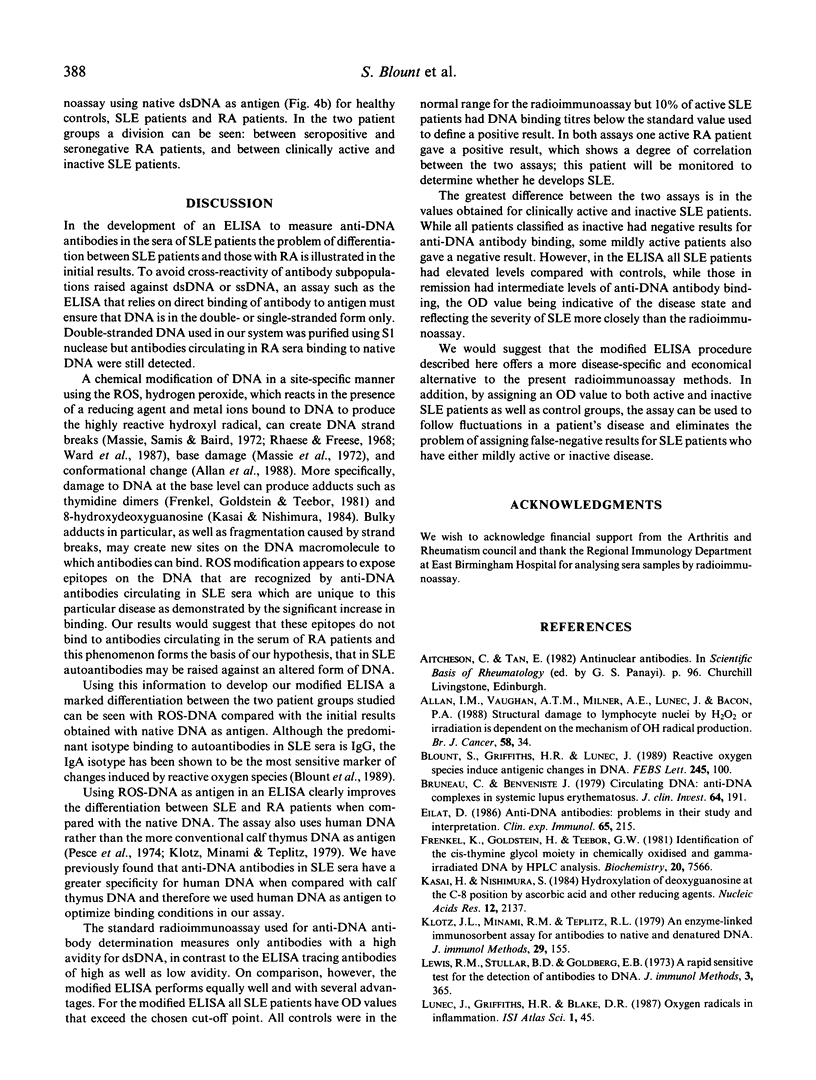
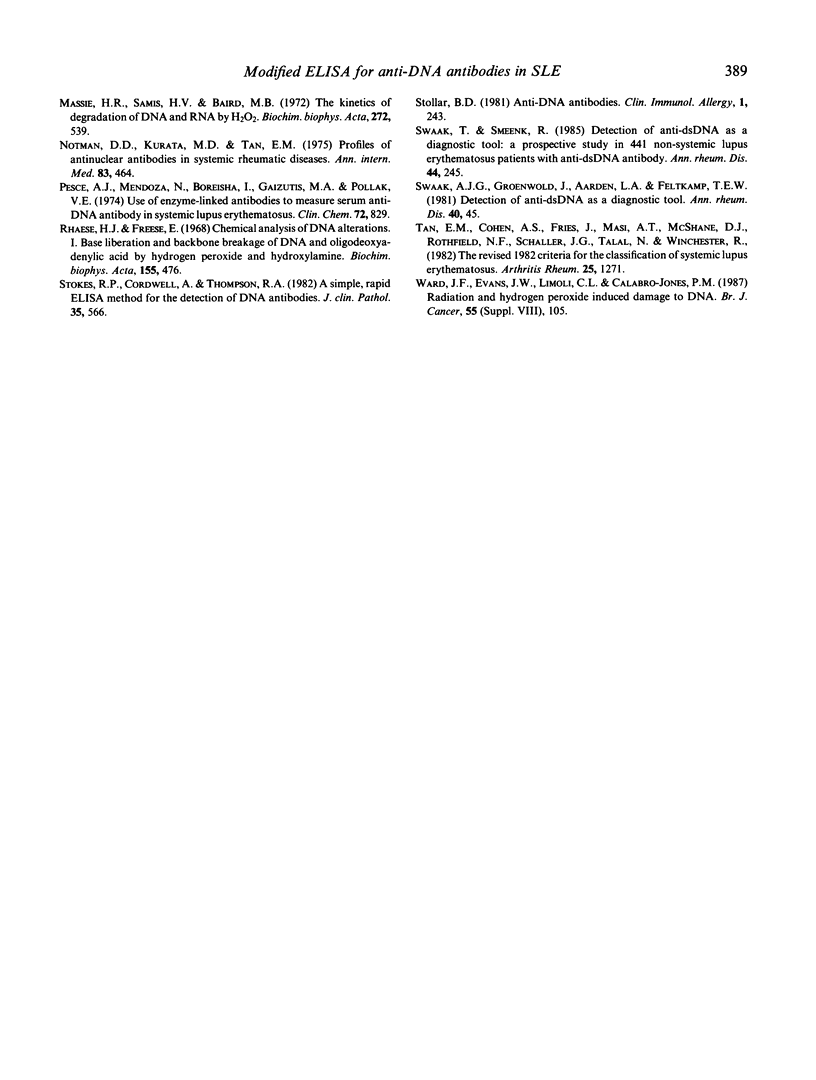
Selected References
These references are in PubMed. This may not be the complete list of references from this article.
- Allan I. M., Vaughan A. T., Milner A. E., Lunec J., Bacon P. A. Structural damage to lymphocyte nuclei by H2O2 or gamma irradiation is dependent on the mechanism of OH. radical production. Br J Cancer. 1988 Jul;58(1):34–37. doi: 10.1038/bjc.1988.156. [DOI] [PMC free article] [PubMed] [Google Scholar]
- Blount S., Griffiths H. R., Lunec J. Reactive oxygen species induce antigenic changes in DNA. FEBS Lett. 1989 Mar 13;245(1-2):100–104. doi: 10.1016/0014-5793(89)80200-5. [DOI] [PubMed] [Google Scholar]
- Bruneau C., Benveniste J. Circulating DNA:anti-DNA complexes in systemic lupus erythematosus. Detection and characterization by ultracentrifugation. J Clin Invest. 1979 Jul;64(1):191–198. doi: 10.1172/JCI109439. [DOI] [PMC free article] [PubMed] [Google Scholar]
- Eilat D. Anti-DNA antibodies: problems in their study and interpretation. Clin Exp Immunol. 1986 Aug;65(2):215–222. [PMC free article] [PubMed] [Google Scholar]
- Frenkel K., Goldstein M. S., Teebor G. W. Identification of the cis-thymine glycol moiety in chemically oxidized and gamma-irradiated deoxyribonucleic acid by high-pressure liquid chromatography analysis. Biochemistry. 1981 Dec 22;20(26):7566–7571. doi: 10.1021/bi00529a035. [DOI] [PubMed] [Google Scholar]
- Kasai H., Nishimura S. Hydroxylation of deoxyguanosine at the C-8 position by ascorbic acid and other reducing agents. Nucleic Acids Res. 1984 Feb 24;12(4):2137–2145. doi: 10.1093/nar/12.4.2137. [DOI] [PMC free article] [PubMed] [Google Scholar]
- Klotz J. L., Minami R. M., Teplitz R. L. An enzyme-linked immunosorbent assay for antibodies to native and denatured DNA. J Immunol Methods. 1979;29(2):155–165. doi: 10.1016/0022-1759(79)90065-6. [DOI] [PubMed] [Google Scholar]
- Massie H. R., Samis H. V., Baird M. B. The kinetics of degradation of DNA and RNA by H 2 O 2 . Biochim Biophys Acta. 1972 Jul 31;272(4):539–548. doi: 10.1016/0005-2787(72)90509-6. [DOI] [PubMed] [Google Scholar]
- Notman D. D., Kurata N., Tan E. M. Profiles of antinuclear antibodies in systemic rheumatic diseases. Ann Intern Med. 1975 Oct;83(4):464–469. doi: 10.7326/0003-4819-83-4-464. [DOI] [PubMed] [Google Scholar]
- Rhaese H. J., Freese E. Chemical analysis of DNA alterations. I. Base liberation and backbone breakage of DNA and oligodeoxyadenylic acid induced by hydrogen peroxide and hydroxylamine. Biochim Biophys Acta. 1968 Feb 26;155(2):476–490. [PubMed] [Google Scholar]
- Stokes R. P., Cordwell A., Thompson R. A. A simple, rapid ELISA method for the detection of DNA antibodies. J Clin Pathol. 1982 May;35(5):566–573. doi: 10.1136/jcp.35.5.566. [DOI] [PMC free article] [PubMed] [Google Scholar]
- Swaak A. J., Groenwold J., Aarden L. A., Feltkamp T. E. Detection of anti-dsDNA as diagnostic tool. Ann Rheum Dis. 1981 Feb;40(1):45–49. doi: 10.1136/ard.40.1.45. [DOI] [PMC free article] [PubMed] [Google Scholar]
- Swaak T., Smeenk R. Detection of anti-dsDNA as a diagnostic tool: a prospective study in 441 non-systemic lupus erythematosus patients with anti-dsDNA antibody (anti-dsDNA). Ann Rheum Dis. 1985 Apr;44(4):245–251. doi: 10.1136/ard.44.4.245. [DOI] [PMC free article] [PubMed] [Google Scholar]
- Tan E. M., Cohen A. S., Fries J. F., Masi A. T., McShane D. J., Rothfield N. F., Schaller J. G., Talal N., Winchester R. J. The 1982 revised criteria for the classification of systemic lupus erythematosus. Arthritis Rheum. 1982 Nov;25(11):1271–1277. doi: 10.1002/art.1780251101. [DOI] [PubMed] [Google Scholar]
- Ward J. F., Evans J. W., Limoli C. L., Calabro-Jones P. M. Radiation and hydrogen peroxide induced free radical damage to DNA. Br J Cancer Suppl. 1987 Jun;8:105–112. [PMC free article] [PubMed] [Google Scholar]


